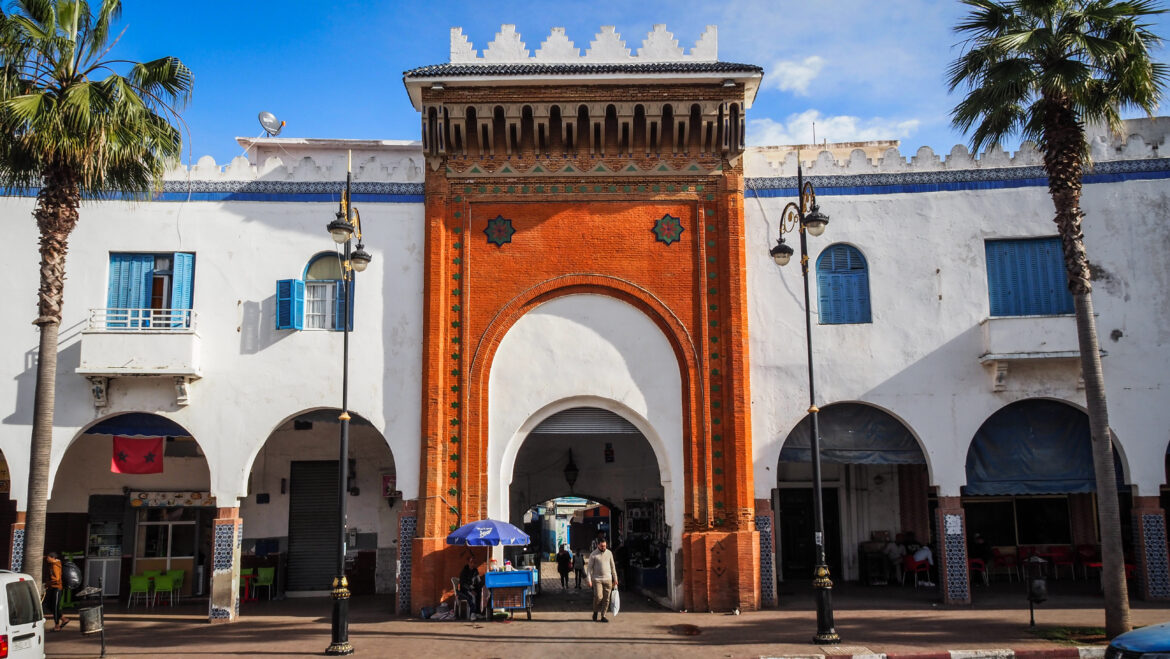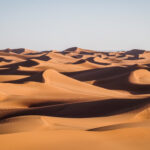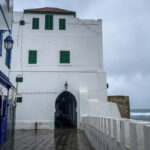Larache is a coastal city in northern Morocco known for its rich history, vibrant culture, and picturesque location along the Atlantic Ocean. It has historical ties to Moorish and Spanish influences, reflected in its architecture and cultural heritage. Founded during the Islamic period, it later became an important port city under Spanish rule before returning to Moroccan sovereignty.
The city is particularly famous for its laid-back atmosphere and stunning landscapes, including sandy beaches and the nearby Loukkos River. One of the most notable sites near Larache is Lixus, an ancient archaeological site with Phoenician, Carthaginian, and Roman ruins. Lixus is believed to have been one of the oldest continuously inhabited settlements in the region and is often associated with myths, including the story of the Labors of Hercules.
The medina (old town) of Larache offers a blend of traditional Moroccan life with Spanish colonial-era influences. Its streets are lined with whitewashed buildings, colourful markets, and small cafes. The city’s vibrant port and fishing industry play a key role in its local economy, contributing to its culinary traditions, which heavily feature fresh seafood.
How to get there?
By Air
The nearest international airports to Larache are:
Tangier Ibn Battuta Airport (TNG): About 85 km north of Larache. From here, you can take a taxi, train or bus.
Rabat-Salé Airport (RBA): Around 150 km south of Larache, also accessible by road or train.
By Train
Larache is not directly served by a train station, but the nearest station is in Ksar El-Kebir, about 30 km away. From Ksar El-Kebir, you can take a shared taxi or local transport to reach Larache.
The ONCF (Moroccan National Railway) network connects major cities like Tangier, Rabat, Casablanca, and Fez to Ksar El-Kebir.
By Bus
Several bus companies operate routes to Larache from major cities in Morocco:
CTM: Known for comfort and reliability, offers services from cities like Tangier, Casablanca, Rabat, and Fez.
Private buses: Less expensive but may be less punctual or comfortable.
By Grand Taxi
Shared taxis (Grand Taxis) are a popular way to travel between cities in Morocco. You can take a Grand Taxi to Larache from nearby cities like Tangier, Ksar El-Kebir, or Asilah.
By Car
Larache is easily accessible by car:
From Tangier: Take the A1 highway (approximately 1 hour).
From Rabat or Casablanca: Use the A1 highway heading north.
From Fez: Take the N4 and N1 roads via Ksar El-Kebir.
How to get around Larache?
Once in Larache, small taxis and buses are the most common ways to get around. Walking is also an excellent way to explore the city, especially the medina and the port area.
Where to stay?
I selected La Maison Haute for its great location inside the medina and good quality-to-price ratio. I wasn’t disappointed. There was everything that I needed for my short, one-night stay and the hosts were friendly, even though communication in English was limited. A good breakfast was included in the price.
The best time to visit
Spring (March to May)
Temperatures are moderate, ranging from 18°C to 25°C. The landscapes are lush and green due to the previous winter rains. It’s a perfect time for outdoor activities like visiting Lixus, strolling through the medina, or enjoying the beaches. It’s less crowded than summer.
Autumn (September to November)
Similar to spring, with temperatures between 20°C and 27°C. The sea is still warm enough for swimming after the summer heat. Quieter than in summer, with fewer tourists, and the weather is comfortable for sightseeing.
Summer (June to August)
Hot and sunny, with temperatures often reaching 30°C to 35°C. Coastal breezes help keep the heat manageable. Best time for beachgoers, as the beaches are lively and the water is warm. However, it can be crowded, especially with local and international tourists.
Winter (December to February)
Cooler but mild, with temperatures between 10°C and 18°C. Occasional rain is possible. Ideal period for a peaceful visit, as the city is less busy. While beach activities may be limited, it’s a great time to explore cultural and historical attractions.
For the best balance of pleasant weather and fewer crowds, spring or autumn is highly recommended.

What to see in Larache?
I started my exploration from Liberation Square (Spanish Square). A very lively spot where local residents gather to catch up with friends and unwind over coffee or tea. This circular plaza was constructed by the Spanish and is located just next to Larache’s historic medina. It is surrounded by exquisite Hispano-Moorish buildings, most of which are now terrace cafes. There are lots of palm palms and a fountain which makes it an ideal spot to relax and observe people.
While walking around the square, you can’t miss the huge Bab al-Khemis, which is the entrance to the medina. Over the past century, not much has changed in the blue-and-white area. It is mostly residential and centred on the expansive covered market known where household products and fresh food are offered for sale.


Fort Kebibat at the northern end of the medina is a 16th-century fort, built by the Portuguese. Unfortunately, today it lays in ruins with lots of trash around and cannot be visited. From there, it’s a good idea to have a walk along the corniche, or even have a glass of tea at the terraces to enjoy panoramic views over the Loukos River and the port.
There is not much to see in the port itself unless you want to buy fresh fish at the pier. You may have it grilled for you at one of the restaurants nearby.




On the other side of the Loukos River, you may find the best beach in town, known as Peligrosa. It’s reachable by small boats from the port and corniche area or you can drive there by car, taking the less direct way passing by Lixus Archeological Site.
Worth mentioning is also the Church of Our Lady of the Pilar which dates back to 1931 and is located near Liberation Square. Very pretty from the outside but unfortunately, it was closed to visitors on the day of my visit. Today it is the center of a local community that organizes cultural activities.

A short walking distance from the church stands the Laqaliq Castle (Stork’s Castle). This is another stunning example of Renaissance military architecture. Originally having imposing bastions at each angle until one was lost, the castle takes the shape of an equilateral triangle. Up until the sixteenth century, it served as the medina’s institutional and representative hub and protected the road leading to Fez.
Nearby, you will notice the Jewish Tower. Oral histories state that the incorrect name resulted from the widespread rumour that a Jewish doctor who lived in that tower treated Sultan Alsaadi during the well-known Wadi Almakhain Battle in the sixteenth century.

There is a large Muslim Cemetery on the other side of the road.
I left the best for the end and after finishing sightseeing around the city centre, I took a taxi to Lixus Archeological Site. I was the only tourist there which added to the experience and made the experience more intimate. The atmosphere was amazing and I especially liked the part of the ruins located on top of the hill with wide-open panoramic views. But let me share with you the historical background of Lixus!
Lixus was founded by the Phoenicians around the 7th or 8th century BCE as a trading post. Its location near the Loukkos River made it an important center for trade and maritime activity. The fertile land and access to water helped it thrive as a hub for agriculture, fishing, and trade with other Mediterranean civilizations.
After the Phoenicians, the Carthaginians took control of Lixus, continuing its development as a key part of their trading network. In 146 BCE, after the fall of Carthage, it came under Roman control, becoming part of the province of Mauretania Tingitana.


Lixus is famously associated with Greek mythology, particularly the Labors of Hercules. According to legend, it was in Lixus that Hercules completed his eleventh labour by retrieving the Golden Apples of the Hesperides, which granted immortality. The Hesperides were said to live in a lush garden near Lixus, guarded by the dragon Ladon. This myth gave Lixus a sense of mystery and divine importance, drawing interest from ancient storytellers and travellers.
During the Roman era, Lixus reached its peak. It became a flourishing city with amphitheatres, temples, baths, and residential areas. The Romans built elaborate salt factories and fish-salting facilities to produce garum, a prized fermented fish sauce exported across the empire. Lixus was known for its wealth and cultural significance during this time, serving as a bridge between the Mediterranean world and Africa.


After the fall of the Roman Empire, Lixus began to decline. The rise of other trade centres and political shifts contributed to its gradual abandonment. By the Islamic period, it was largely deserted, with its remaining population moving to nearby Larache.
Today, Lixus is an important archaeological site, showcasing ruins from the Phoenician, Carthaginian, and Roman periods. Visitors can explore its amphitheatre, temples, baths, and the remains of its industrial fish-salting complexes. The site’s hilltop location offers stunning views of the Loukkos River and the surrounding countryside.



